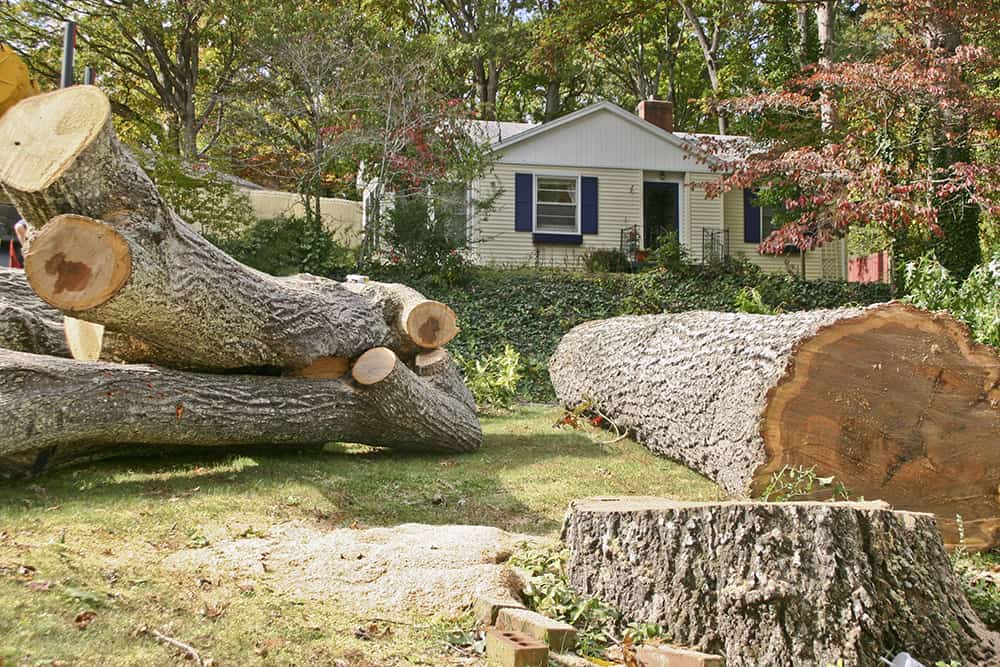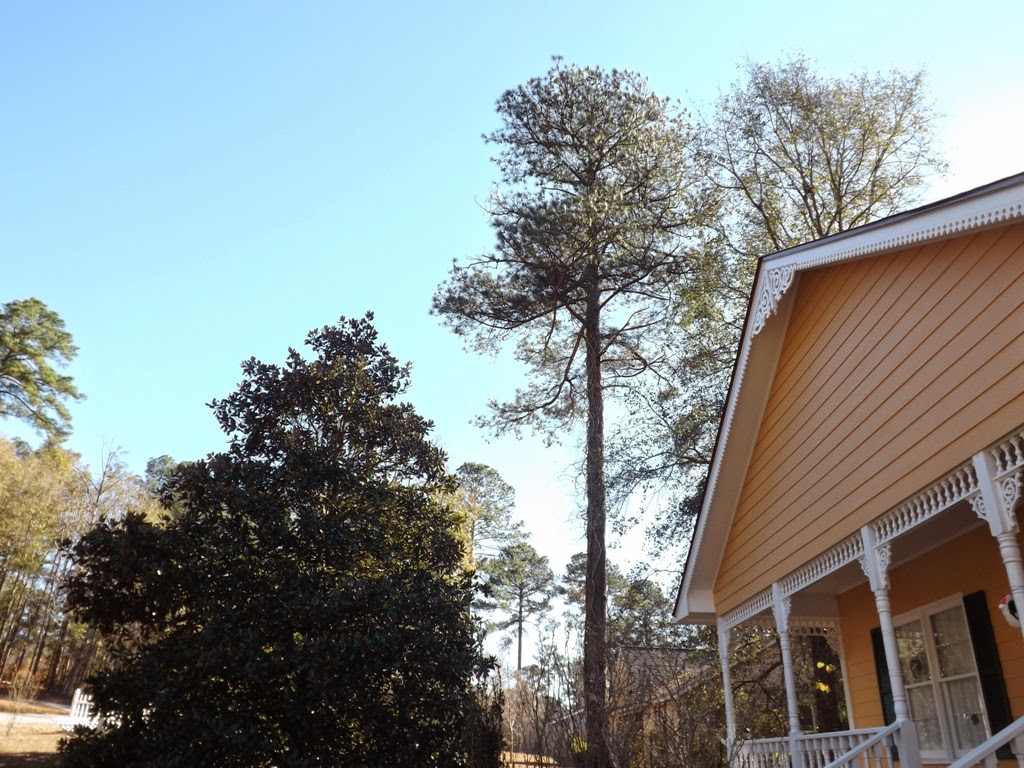If you want to cut down a pine tree near your house, you need to be really careful and take safety seriously. It’s safest to get professionals to do it, but if you want to do it yourself, here’s a simple summary of the steps. First, check local rules and permits. Then, look at the tree and decide where you want it to fall. Wear safety gear, get the right tools, and plan an escape route.
Furthermore, make sure there’s nothing in the way, and cut a notch on the side where you want the tree to fall. Then, make a final cut on the other side. Use wedges to help control the fall and get to your escape route quickly. Once the tree is down, remove the branches and dispose of the tree safely.
What are the key first steps for cutting down a tree near a house?
The preliminary steps involve researching local regulations, assessing the tree’s condition, determining its lean, and gathering the necessary tools and equipment. These steps are essential for ensuring a safe and successful tree removal process. Failing to adequately address any of these factors can lead to accidents, property damage, or legal issues.
Check local regulations and permits
Before you start cutting down a tree, it’s crucial to research and understand the local regulations and obtain any necessary permits. Local laws and regulations can vary widely, and some areas may have restrictions on cutting down certain trees, especially if they are protected species or in designated conservation zones.
Failing to comply with these regulations can lead to legal consequences and fines, so it’s essential to ensure you’re in compliance with the law.
Assess the tree’s size, health, and lean

The tree’s size, health, and lean are critical factors to consider. If the tree is too large or if it’s unhealthy and weak, it may be more challenging and dangerous to cut down. An unhealthy tree may have decay or structural issues that can affect its stability, making it more prone to falling unpredictably.
Additionally, you should determine the tree’s lean, which is the direction it naturally leans. This will impact the direction in which it is likely to fall and is a crucial factor in planning for a safe tree removal.
Decide the direction of the tree’s fall
Once you’ve assessed the tree’s health and lean, you can make an informed decision about the direction in which you want the tree to fall. This decision should take into account safety, avoiding obstacles, and minimizing the potential for damage to your house or other structures. Choosing the fall direction is a critical step in planning the felling process, as it will influence where you create your notch and felling cuts.
Gather necessary tools and equipment
To safely cut down a pine tree, you’ll need the right tools and equipment. Some of the essential tools include a chainsaw, ropes, safety harnesses, wedges, and a ladder. Ensure that all your equipment is in good working condition and properly maintained. Using dull or faulty equipment can make the process more dangerous.
Additionally, it’s a good idea to have safety gear like helmets, gloves, and eye protection for everyone involved in the tree removal process.
How to ensure safe tree cutting near your home?
Safety precautions when cutting down a pine tree involve wearing appropriate safety gear, establishing a clear and marked escape route, and thoroughly clearing the work area of any obstacles.
Wear appropriate safety gear
Safety gear is non-negotiable when it comes to tree cutting. It includes items such as:
- Helmet: Protects your head from falling branches or debris.
- Eye protection: Safeguards your eyes from wood chips and dust.
- Hearing protection: Reduces the noise of the chainsaw.
- Gloves: Offer a secure grip on tools and protect your hands.
- Chainsaw-resistant pants and chaps: Shield against chainsaw injuries.
- Steel-toed boots: Protect your feet from heavy objects.
Wearing this gear may be uncomfortable, but it is essential for your safety. It helps prevent injuries from the many potential hazards during tree cutting.
Establish a safe escape route
Before you start cutting, plan and mark a safe escape route. This route should be clear of obstacles and positioned on the opposite side of the tree’s intended fall direction. Your escape route serves as a quick path to safety in case the tree does not fall as expected, or if there is any other unforeseen danger.
Communicate the escape route to anyone assisting you and ensure everyone is aware of it. Practice the route to ensure a fast and safe exit when needed.
Clear the area of obstacles
Removing obstacles from the area is vital to ensure a safe tree cutting operation. This includes:
Trees or shrubs in the vicinity of the pine tree can be hazardous if they are in the path of the falling tree or could interfere with your work. Remove any fallen branches or debris that may trip you or impede your movement.
Make sure there are no items, like tools or equipment, that could become projectiles during tree cutting. Ensure that onlookers, including pets and children, stay well away from the work area to prevent accidents.
By clearing the area of obstacles and ensuring a safe distance, you reduce the risk of accidents and property damage during the tree removal process.
What’s the right way to cut down a tree near a house?

The tree cutting process involves a series of precision cuts: the horizontal notch cut (face cut) that guides the fall, the creation of a triangular notch for accuracy, the horizontal felling cut (back cut) to initiate the fall, and the use of wedges to control the tree’s descent.
Make a horizontal notch cut (face cut)
The horizontal notch cut, commonly referred to as the “face cut,” is the first cut you make on the side of the tree facing the direction you want it to fall. This cut should be about one-third of the way through the tree’s diameter and should be made with precision.
The face cut should be level and slightly sloping upward to guide the tree in the intended fall direction. It creates a flat surface where the subsequent cuts will be made. The accuracy of the face cut is crucial in controlling the direction of the tree’s fall.
Create a triangular notch:
Once the face cut is complete, you make a second cut, often called the “top cut,” which meets the upper part of the face cut, creating a triangular-shaped notch. This notch should be open toward the direction you want the tree to fall.
The size and shape of the notch can vary depending on the tree’s size and lean. This triangular notch guides the tree to fall in the desired direction and provides a clear target for the felling cut.
Make a horizontal felling cut (back cut)
The felling cut, also known as the “back cut,” is made on the opposite side of the tree from the notch cuts, slightly above the bottom of the notch. It should be level and aligned with the upper part of the triangular notch. The felling cut severs the remaining uncut wood, allowing the tree to start falling.
It is essential to maintain precision when making the felling cut, as an improper angle or height can lead to the tree falling in an unintended direction, causing safety hazards and potential damage.
Use wedges to control the fall
As you make the felling cut, it’s common practice to insert wedges into the cut to help control the tree’s fall. Wedges are typically made of plastic or wood and are used to ensure that the tree falls in the desired direction and to prevent the chainsaw blade from binding.
By placing wedges into the felling cut, you can steer the tree’s path, making adjustments as needed to ensure it falls safely. Wedges can also prevent the tree from pinching the chainsaw, which could be dangerous for the cutter.
FAQ’s
What is the best way to cut down a pine tree?
The best way to cut down a pine tree involves careful planning, following safety precautions, and making precise cuts to control its fall direction.
Are pine trees hard to cut?
Pine trees can be hard to cut, especially if they are large or have dense branches. Proper tools and techniques are crucial.
What happens if you cut a pine tree?
Cutting a pine tree without proper safety precautions and planning can lead to safety hazards, property damage, or environmental impact.
What is the lifespan of a pine tree?
The lifespan of a pine tree varies by species, but many can live for several decades to over a century.
What are the hardest trees to cut down?
Some of the hardest trees to cut down include hardwoods like oak and maple, known for their density and toughness.
Do pine needles fall off trees?
Yes, pine needles do fall off trees as part of their natural seasonal cycle, typically in the autumn.
Final Words
Safety should be your number one concern when cutting down a pine tree near your house. Whether you’re doing it yourself or hiring experts, always follow the rules and get any needed permits. Check the tree’s health, size, and which way it leans, and be sure to wear safety gear like helmets and gloves. Plan a safe escape route, and clear the area of anything that could cause problems.
Furthermore, when it’s time to cut the tree, do it step by step: make the right notches, and use wedges to guide the fall. Never forget that safety is crucial for you and everyone around. If you’re not sure what to do, it’s smart to get help from professionals for a safe and successful tree-cutting job.
